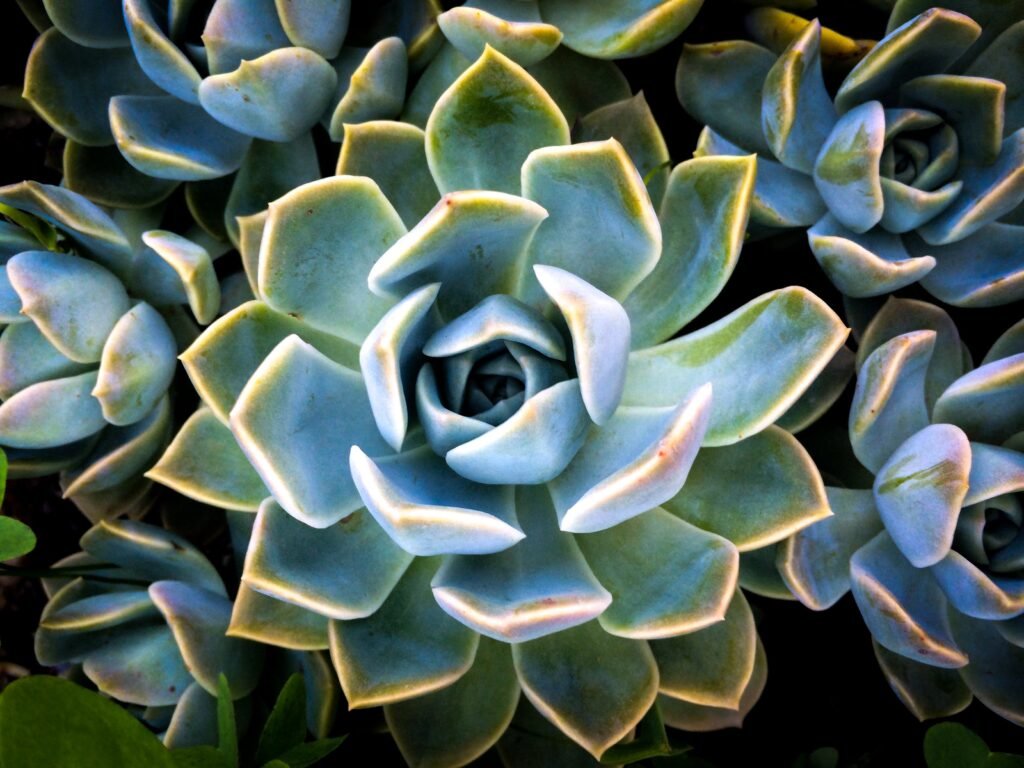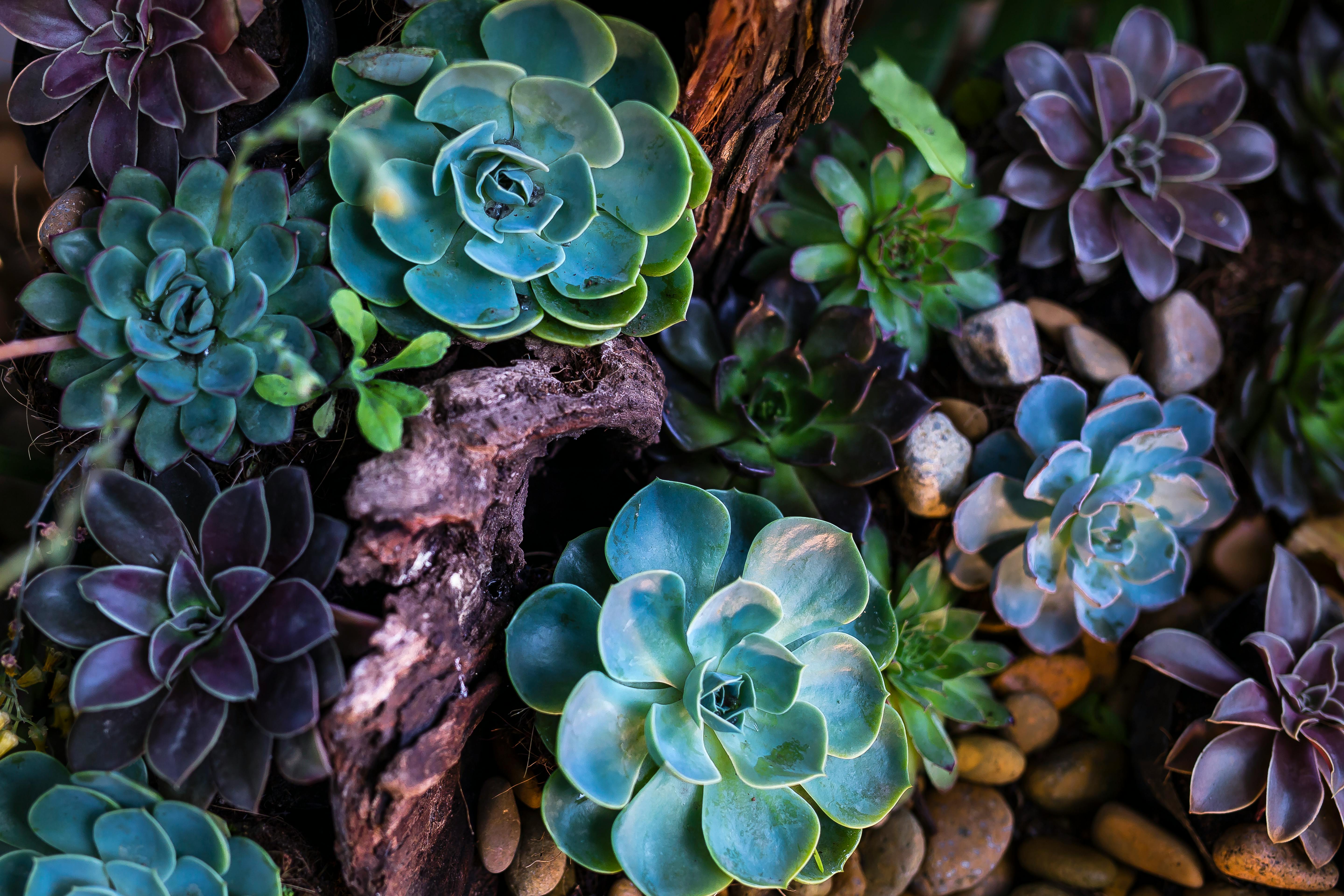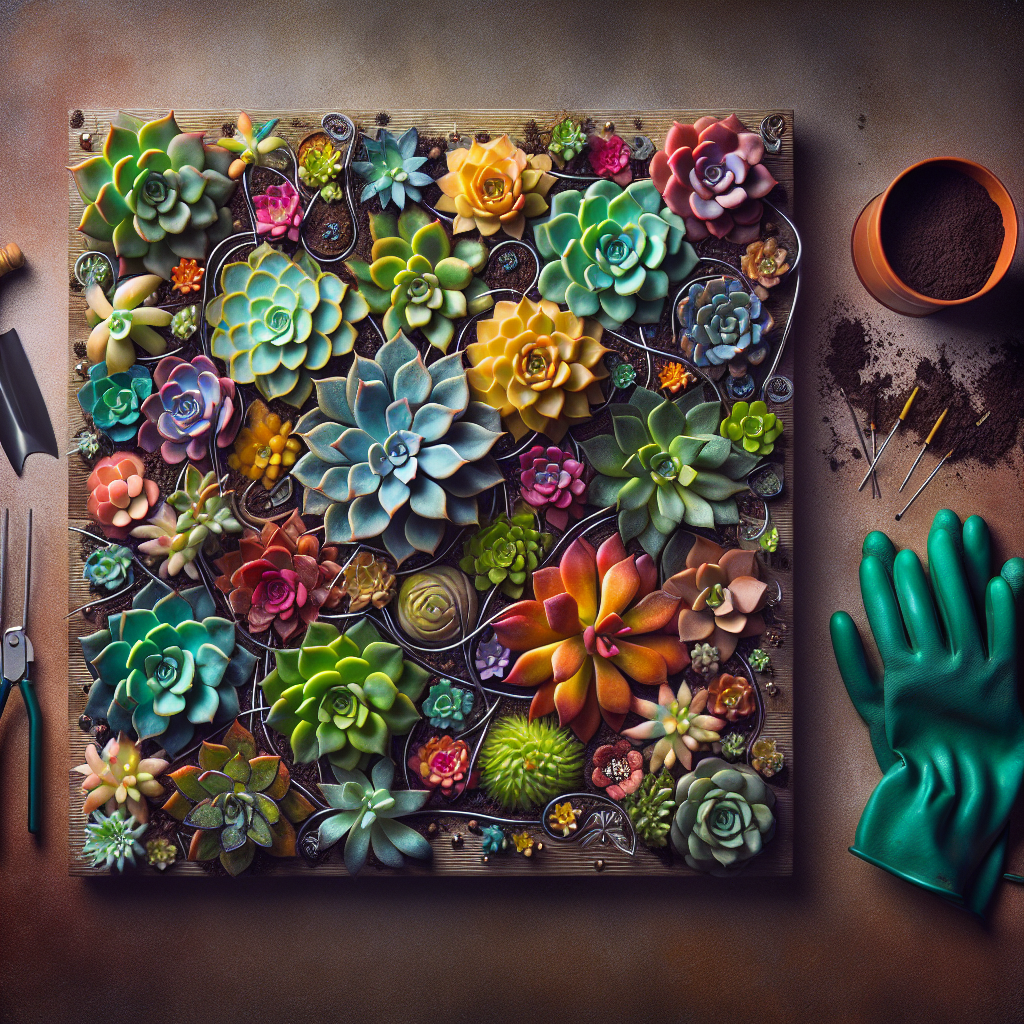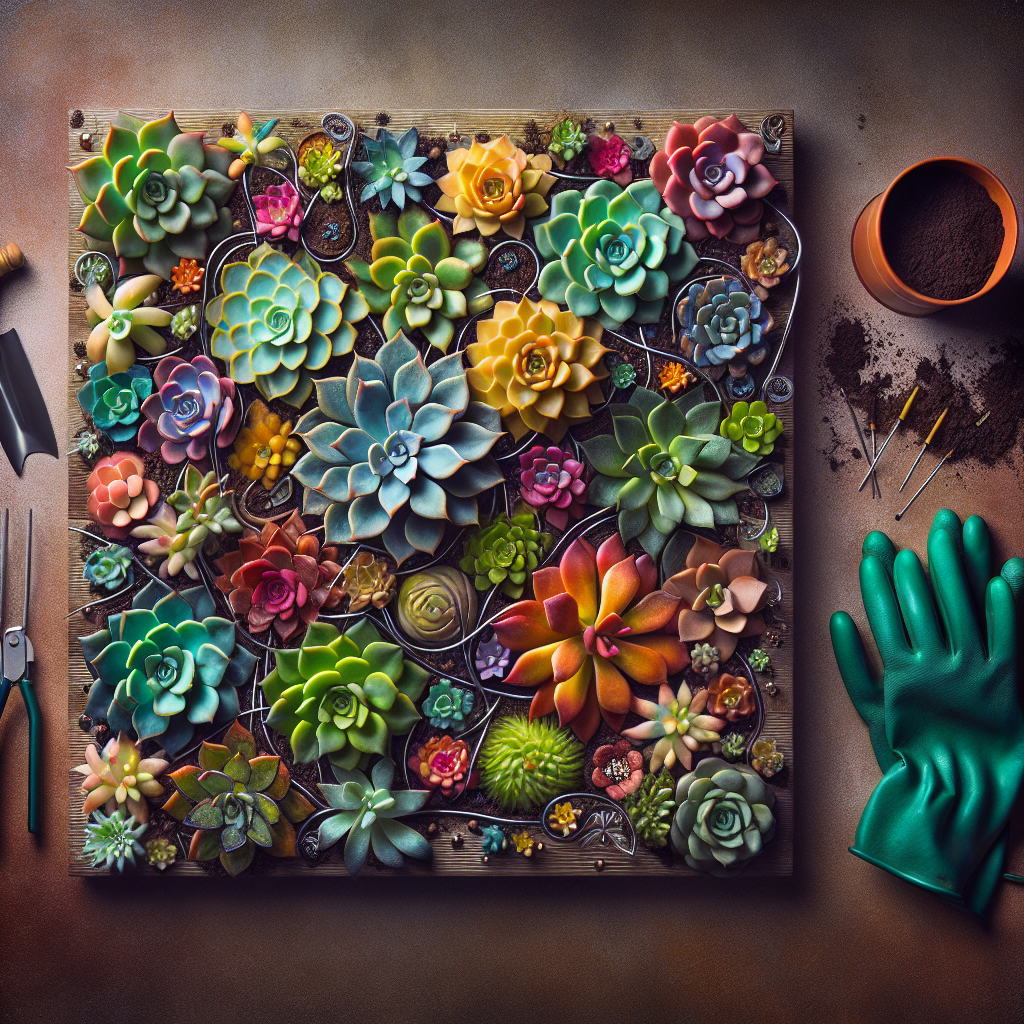Imagine transforming a plain wall into a stunning masterpiece of natural beauty. With just a few simple steps, you can create your very own succulent wall art piece, adding a touch of charm and elegance to any space. By combining your creativity and love for plants, you’ll soon have a living work of art that will leave everyone in awe. So, roll up your sleeves and let’s dive into the world of succulent wall art together.
Choosing the Right Wall
Consider the lighting
When choosing a wall for your succulent wall art piece, it’s important to consider the lighting conditions. Succulents thrive in bright indirect sunlight, so selecting a wall that receives at least four to six hours of sunlight per day is crucial. Make sure to observe the area throughout the day to ensure it meets the lighting requirements for healthy succulent growth.
Evaluate the size
The size of the wall will dictate how many succulents you can include in your wall art piece. A larger wall will allow for more variety and a greater number of plants. However, if you are limited on space, consider creating a smaller succulent wall that still adds a touch of greenery and beauty to your surroundings.
Determine the location
Think about the location of the wall within your home or outdoor space. Consider whether you want to create a focal point in your living room, add greenery to your patio, or spruce up a bare fence. Choosing a location that complements the overall aesthetic of the space will ensure that your succulent wall art piece becomes a stunning addition that enhances the atmosphere.
Selecting the Perfect Succulents
Research different types
Before diving into the selection process, it’s important to research the different types of succulents available. There are various shapes, sizes, and colors to choose from, ranging from the popular Echeveria to the unique Aeonium. Each succulent has its own unique care requirements, so understanding their characteristics and preferences will help you make informed choices later on.
Consider growth requirements
When selecting succulents for your wall art piece, consider their growth requirements. Some succulents are slower-growing, while others can quickly spread and fill up space. Take into account the mature size of each succulent you’re interested in and make sure they won’t outgrow the planter boxes too quickly. Balancing different growth rates will help create a visually pleasing arrangement that maintains its beauty over time.
Choose a color palette
Succulents come in a wide range of colors, from vibrant greens to deep purples and even shades of blue. Consider the color palette you want to achieve in your wall art piece. Do you prefer a monochromatic look with varying shades of green, or perhaps you’re drawn to warm tones with pops of orange and red? By carefully selecting succulents with complementary colors, you can create an artistic arrangement that is visually appealing and cohesive.

Preparing the Wall
Clean the surface
Before you begin attaching planter boxes to your wall, it’s important to clean the surface thoroughly. Remove any dirt, dust, or debris that may interfere with the adhesive or compromise the longevity of your succulent wall art piece. Use a mild soap and water solution to gently wash the wall, ensuring that it is free from any substances that could hinder the adherence of the planter boxes.
Apply a primer
To help the adhesive bond effectively with the wall’s surface, consider applying a primer. A primer will provide a smooth and clean base for the adhesive to adhere to, ensuring a strong and long-lasting bond. Follow the instructions on the primer product and allow it to dry completely before moving on to the next step.
Create a sturdy framework
When creating a succulent wall art piece, it’s important to establish a sturdy framework to support the weight of the planter boxes and the succulents. This will provide stability and ensure that the arrangement stays intact over time. Whether you choose to use a trellis system or build a wooden frame, make sure it is securely attached to the wall and can withstand the weight of the succulents and the potential stress of watering.
Creating the Succulent Planter Boxes
Choose appropriate materials
Selecting the right materials for your succulent planter boxes is essential for their durability and functionality. Opt for materials that are weather-resistant, such as cedar or redwood, to ensure long-term use. Avoid using materials that may deteriorate or warp when exposed to moisture, as succulents require occasional watering.
Measure and cut the boxes
Measure the dimensions of your wall and planter boxes before cutting the materials. Ensure that the boxes are deep enough to accommodate the roots of the succulents while leaving enough space for a well-draining soil mix. Precise measurements and cuts will ensure that the planter boxes fit snugly against the wall and contribute to the overall visual appeal of your succulent wall art piece.
Secure the boxes to the wall
Attach the planter boxes securely to the wall using the appropriate mounting brackets, screws, or nails. Ensure that the boxes are level and evenly spaced to create a balanced and visually appealing arrangement. Take the time to double-check the stability of the boxes to prevent any accidents or damage to your succulent wall art piece.

Establishing a Watering System
Install irrigation drip lines
To maintain proper hydration for your succulent wall art piece, consider installing irrigation drip lines. These systems will distribute water evenly to each planter box, ensuring that all succulents receive the moisture they need. Drip lines also help prevent overwatering by controlling the amount of water delivered to each plant. Follow the manufacturer’s instructions to install the drip lines effectively.
Consider a reservoir system
Another watering system option is a reservoir system, which allows for self-watering by providing a water source at the base of the planter boxes. This method can reduce the frequency of watering and make it easier to maintain the proper moisture levels for your succulents. Ensure that the reservoir system is properly designed and installed to prevent any water overflow or leakage.
Test the watering system
Before planting your succulents, test the watering system to ensure that it functions properly. Check for leaks, water flow issues, or any other potential problems. Adjust the water flow as needed to meet the specific watering requirements of your succulents. By testing the watering system beforehand, you can identify and address any issues early on and provide your succulents with the optimal environment for growth.
Preparing the Soil
Use a well-draining soil mix
Succulents thrive in well-draining soil that allows excess water to flow away from their roots quickly. To create the perfect soil mix for your succulent wall art piece, combine equal parts of potting soil and perlite or pumice. This blend will help prevent waterlogging and create an optimal growing environment for your succulents.
Consider adding perlite or sand
To further enhance the soil’s drainage capabilities, consider adding perlite or coarse sand to the mixture. These amendments will increase the porosity of the soil, allowing excess water to move freely and avoid pooling around the roots. This step will help prevent root rot and ensure the long-term health of your succulents.
Ensure proper moisture retention
While well-draining soil is essential, it’s important to ensure that the soil retains enough moisture for your succulents to thrive. Consider incorporating water-retaining additives, such as coconut coir or peat moss, to the soil mix. These additives will help increase the soil’s water-holding capacity, ensuring that your succulents receive the necessary moisture between watering intervals.

Arranging and Planting Succulents
Plan the design and layout
Before planting your succulents, take the time to plan the design and layout of your wall art piece. Consider the size and shape of each succulent, as well as their colors and textures. By arranging them strategically, you can create pleasing patterns and focal points. Experiment with different placement options and visualize how the succulents will grow and interact with one another over time.
Start with larger succulents
When planting your succulents, it’s generally best to start with the larger ones. These larger succulents will serve as anchor plants and provide a strong visual foundation for your arrangement. Place them strategically within the planter boxes to create height, depth, and texture. This approach will help establish a visually appealing structure for your succulent wall art piece.
Fill in gaps with smaller succulents
After placing your larger succulents, fill in the remaining gaps with smaller succulents. Choose varieties that complement the anchor plants and add interest and diversity to your arrangement. Nestle them between the larger succulents, taking care not to overcrowd the planter boxes. The combination of larger and smaller succulents will create a visually stunning display that is both balanced and captivating.
Caring for the Succulent Wall Art Piece
Monitor watering needs
Regularly monitor the watering needs of your succulent wall art piece. While succulents are known for their ability to withstand drought, they still need proper hydration to thrive. Stick your finger one inch deep into the soil, and if it feels dry, it’s time to water. Avoid overwatering, as this can lead to root rot and other related issues. Strike a balance by providing enough water to keep the soil slightly moist but not waterlogged.
Provide proper sunlight
Ensure that your succulent wall art piece receives the required amount of sunlight. Most succulents thrive in bright indirect sunlight, so placing your wall art piece near a window with filtered light or in a sunny outdoor spot with shade during the hottest hours of the day is ideal. Monitor the sunlight exposure and adjust the wall art piece’s location if necessary to prevent sunburn or excessive stretching of the succulents.
Prune and remove dead plants
Regularly inspect your succulent wall art piece for any dead or dying plants. Prune away any dead leaves or stems, as they can affect the health and appearance of the surrounding succulents. Removing dead plants promptly will prevent the spread of diseases and pests and maintain the overall beauty and vitality of your succulent wall art piece.

Dealing with Potential Challenges
Preventing pests and diseases
Despite their resilience, succulents can still be susceptible to pests and diseases. Monitor your succulent wall art piece regularly for signs of infestation or disease, such as pests, discoloration, or wilting. Address any issues promptly by using appropriate pest control measures or treating diseases according to specific instructions. Regular maintenance and vigilance will help prevent and mitigate potential challenges.
Managing overgrowth
As your succulents grow, you may face challenges related to overgrowth. Some succulents have a tendency to spread quickly, potentially crowding out neighboring plants. Regularly trim and cut back overgrown succulents to maintain the desired shape and prevent overcrowding. By managing overgrowth, you can ensure that each succulent has enough space to thrive and contribute to the aesthetic appeal of your wall art piece.
Reviving unhealthy succulents
Despite your best efforts, some succulents may occasionally show signs of declining health. If you notice wilting, discoloration, or poor growth, take immediate action to revive the plant. Check for potential causes, such as improper watering, inadequate sunlight, or nutrient deficiencies. Make the necessary adjustments to address the issue, such as adjusting the watering schedule or providing additional sunlight. With timely care and attention, you can often nurse unhealthy succulents back to health.
Enhancing the Aesthetic Appeal
Adding decorative elements
To enhance the aesthetic appeal of your succulent wall art piece, consider adding decorative elements. Incorporate rocks, pebbles, or colored glass beads in the planter boxes to bring texture and visual interest to the arrangement. These elements can serve as a backdrop to highlight the beauty of your succulents and further elevate the overall design.
Incorporating hanging plants
In addition to the planter boxes, consider incorporating hanging plants to add dimension and depth to your succulent wall art piece. Choose trailing succulents, such as String of Pearls or Burro’s Tail, and position them strategically to cascade down from the planter boxes. This creates a visually pleasing vertical element that adds movement and an extra touch of beauty to your wall art piece.
Using different succulent textures
To create a visually captivating succulent wall art piece, utilize different succulent textures. Combine succulents with smooth leaves, like Haworthia, with those that have intricate patterns, such as Echeveria ‘Lola.’ By incorporating a variety of textures, you can create visual interest and add complexity to your wall art piece. Experiment with different textures and observe how they interact with each other to find the perfect balance.
Creating a succulent wall art piece is an exciting and rewarding project. By carefully choosing the right wall, selecting the perfect succulents, preparing the wall and soil, establishing a watering system, and caring for your creation, you can enjoy a stunning display of greenery that adds beauty and life to your surroundings. Remember to overcome potential challenges with proper maintenance and enhance the aesthetic appeal by incorporating decorative elements, hanging plants, and different succulent textures. With a little effort and creativity, you can create an eye-catching succulent wall art piece that will be the envy of all who see it. So go ahead, unleash your inner artist, and create your succulent masterpiece!


